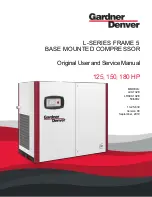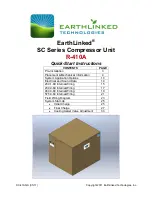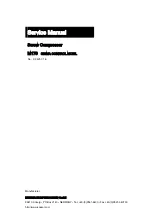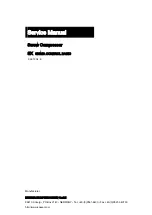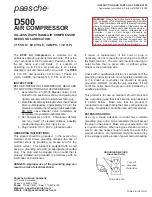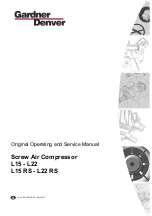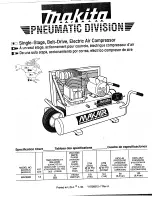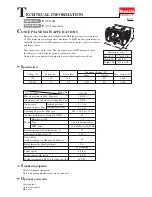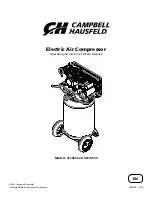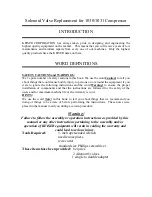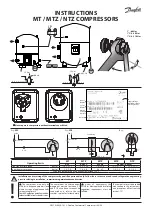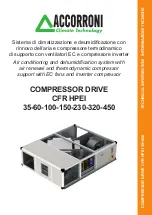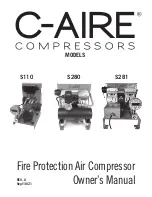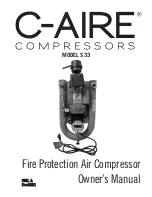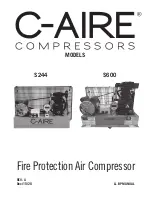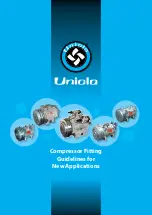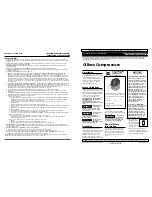
Danfoss can accept no responsibility for possible errors in catalogues, brochures and other printed material. Danfoss reserves the right to alter its products without notice. This also applies to products
already on order provided that such alterations can be made without subsequential changes being necessary
eady agreed.
All trademarks in this material are property of the respective companies. Danfoss and the Danfoss logotype are trademarks of Danfoss A/S. All rights reserved.
2 | © Danfoss | DCS (CC) | 2018.04
8510287P01B - FRCC.PI.054.A2.02
Danfoss A/S
6430 Nordborg
Denmark
4 – Assembly
•
Slowly release the nitrogen holding charge
through the schrader port.
•
Remove the gaskets when brazing rotolock
connectors.
• Always use new gaskets for assembly.
• Connect the compressor to the system as soon
as possible to avoid oil contamination from am-
bient moisture.
• The PCH065 is dedicated for heat pump system
and has been designed to work with an econo-
mizer system. The compressor injection port
must be connected to the outlet of the interme-
diated exchanger. A solenoid must be installed
on the injection line: this injection port must be
closed when the compressor is stopped, while it
is running in the non-injection area of the appli-
cation map and during inversed cycle (cooling
mode and defrost).
• Avoid material entering into the system while
cutting tubes. Never drill holes where burrs can-
not be removed.
• Braze with great care using state-of-the-art tech-
nique and vent piping with nitrogen gas flow.
• Connect the required safety and control devices.
When the schrader port is used for this, remove
the internal valve. Do not exceed the maximum
tightening torque for rotolock connections:
Rotolock connections
Tightening torque
1" rotolock
80 Nm
1 1/4" rotolock
90 Nm
1 3/4" rotolock
110 Nm
2 1/4" rotolock
130 Nm
5 – Leak detection
Never pressurize the circuit with oxygen or dry
air. This could cause fire or explosion.
• Do not use dye for leak detection.
• Perform a leak detection test on the complete
system.
• The test pressure must not exceed 1.1 x Ps value for
LP side and PS value for HP side indicated on com-
pressor nameplate
• When a leak is discovered, repair the leak and
repeat the leak detection.
6 – Vacuum dehydration
• Never use the compressor to evacuate the sys-
tem.
• Connect a vacuum pump to both the LP & HP
sides.
• Pull down the system under a vacuum of 500
µm Hg (0.67 mbar) absolute.
• Do not use a megohmmeter nor apply power to
the compressor while it is under vacuum as this
may cause internal damage.
7 – Electrical connections
• Switch off and isolate the main power supply.
See overleaf for wiring details.
• All electrical components must be selected as
per local standards and compressor require-
ments.
• Refer to page for electrical connections details.
• The Danfoss scroll compressor only works cor-
rectly in one rotation direction. Line phases L1,
L2, L3 must absolutely be connected to com-
pressor terminals T1, T2, T3 to avoid reverse
rotation.
• Use ø 4.8 mm (3/16») screws and ¼» ring termi-
nals for the power connection. Fasten with 3 Nm
torque.
• The compressor must be connected to earth
with the 5 mm earth terminal screw.
8 – Filling the system
• Keep the compressor switched off.
• Fill the refrigerant in liquid phase into the conden-
ser or liquid receiver. The charge must be as close
as possible to the nominal system charge to avoid
low pressure operation and excessive superheat.
Never let the pressure on LP side exceed the pres-
sure on HP side with more than 5 bar. Such pres-
sure difference could cause internal compressor
damage.
• Keep the refrigerant charge below the indicated
charge limits if possible. Above this limit; protect
the compressor against liquid flood-back with a
pump-down cycle or suction line accumulator.
• Never leave the filling cylinder connected to the
circuit.
Compressor models Refrigerant charge limit (kg)
PCH065
13.5
9 – Verification before commissioning
Use safety devices such as safety pressure
switch and mechanical relief valve in compliance
with both generally and locally applicable regu-
lations and safety standards. Ensure that they are
operational and properly set.
Check that the settings of high-pressure swit-
ches and relief valves don’t exceed the maximum
service pressure of any system component.
•
A low-pressure switch is recommended to
avoid vacuum operation. Minimum setting for
PCH065 is 1.7 bar g.
• Verify that all electrical connections are properly
fastened and in compliance with local regula-
tions.
• When a crankcase heater is required, it must be
energized at least 12 hours before initial start-
up and start-up after prolonged shutdown for
belt type crankcase heaters (6 hours for surface
sump heaters).
10 – Start-up
• Never start the compressor when no refrigerant
is charged.
• All service valves must be in the open position.
• Balance the HP/LP pressure.
• Energize the compressor. It must start promptly.
If the compressor does not start, check wiring
conformity and voltage on terminals.
• Eventual reverse rotation can be detected by
following phenomena; the compressor doesn’t
build up pressure, it has abnormally high sound
level and abnormally low power consumption.
In such case, shut down the compressor imme-
diately and connect the phases to their proper
terminals. Danfoss scroll compressor PCH065 is
protected against reverse rotation by the exter-
nal electronic protection module. They will shut
off automatically.
11 – Check with running compressor
• Check current draw and voltage.
• Check suction superheat to reduce risk of slug-
ging.
• Observe the oil level in the sight glass for about
60 minutes to ensure proper oil return to the
compressor.
• Respect the operating limits.
• Check all tubes for abnormal vibration. Move-
ments in excess of 1.5 mm require corrective
measures such as tube brackets.
•
When needed, additional refrigerant in liquid
phase may be added in the low-pressure side as
far as possible from the compressor. The compres-
sor must be operating during this process.
• A minimum injection superheat of 5 K must be
respected.
• Do not overcharge the system.
• Never release refrigerant to atmosphere.
• Before leaving the installation site, carry out a
general installation inspection regarding clean-
liness, noise and leak detection.
• Record type and amount of refrigerant charge
as well as operating conditions as a reference for
future inspections.
12 – Maintenance
Internal pressure and surface temperature
are dangerous and may cause permanent injury.
Maintenance operators and installers require
appropriate skills and tools. Tubing temperature
may exceed 100°C and can cause severe burns.
Ensure that periodic service inspections to
ensure system reliability and as required by local
regulations are performed.
To prevent system related compressor problems,
following periodic maintenance is recommended:
• Verify that safety devices are operational and
properly set.
• Ensure that the system is leak tight.
• Check the compressor current draw.
• Confirm that the system is operating in a way
consistent with previous maintenance records
and ambient conditions.
• Check that all electrical connections are still
adequately fastened.
• Keep the compressor clean and verify the ab-
sence of rust and oxidation on the compressor
shell, tubes and electrical connections.
13 - Warranty
Always transmit the model number and serial number
with any claim filed regarding this product.
The product warranty may be void in following cases:
• Absence of nameplate.
•
External modifications; in particular, drilling,
welding, broken feet and shock marks.
• Compressor opened or returned unsealed.
• Rust, water or leak detection dye inside the
compressor.
• Use of a refrigerant or lubricant not approved by
Danfoss.
• Any deviation from recommended instructions
pertaining to installation, application or mainte-
nance.
• Use in mobile applications.
• Use in explosive atmospheric environment.
• No model number or serial number transmitted
with the warranty claim. The compressor is not
designed to withstand natural disasters such
as earthquakes, cyclones, floods…. or extreme
events such as fires, terrorist attacks, military
bombardments, or explosions of any kind.
Danfoss Commercial Compressor is not liable
for any malfunction of its product resulting from
such events
14 – Disposal
Danfoss recommends that compressors
and compressor oil should be recycled
by a suitable company at its site.



